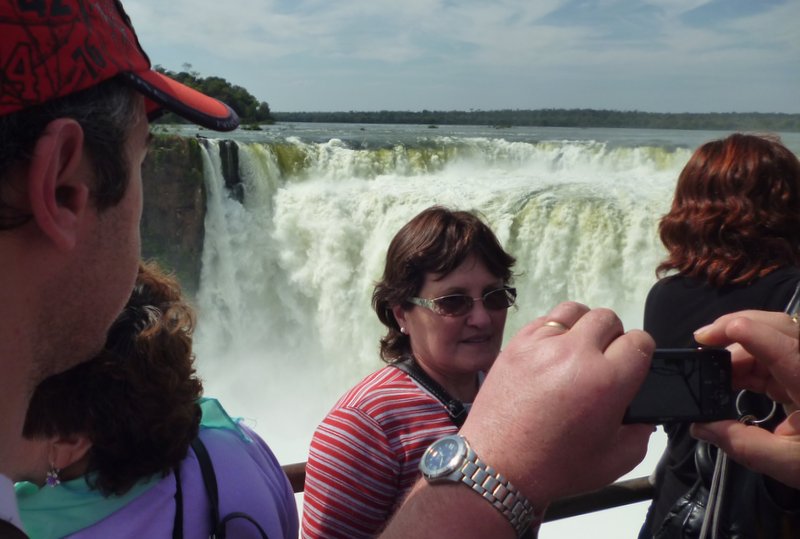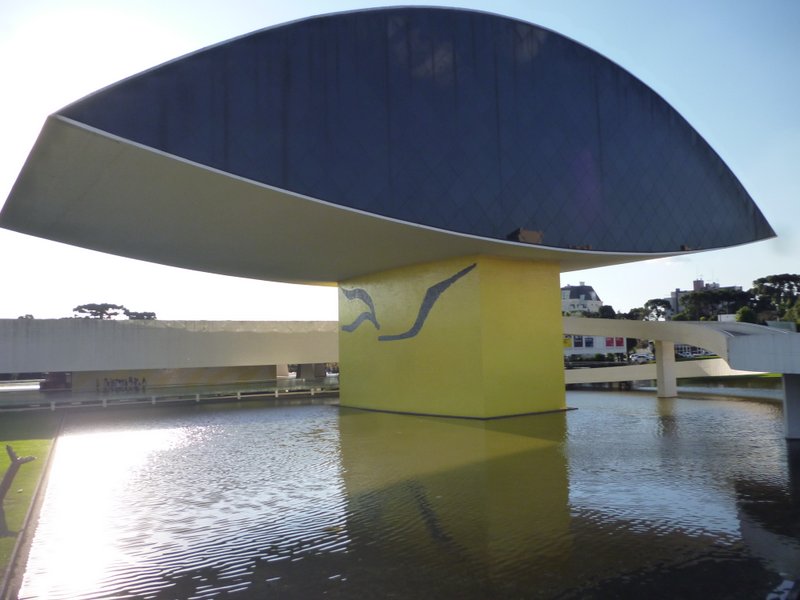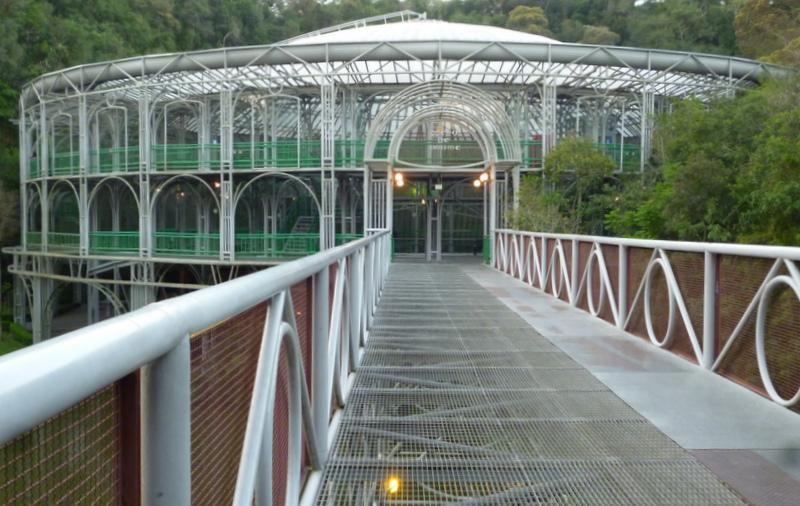Brazil
I hadnt specifically included Brazil in my itinerary of South American countries for what I accept is a bizarre reason but it made sense to me. Having, after two years of travelling in Latin America finally gained a precarious grasp of Spanish; I figured that going to Portuguese speaking Brazil would confuse my Spanish rather than assist my Portuguese. However, as it was the easiest way of getting to Uruguay, I did ride through the small south eastern corner of Brazil, which is remarkably large, while Uruguay turned out to be remarkably small.

My First Glimpse Of Brazil On The Opposite Side Of Iguazu Falls Through The Bank Holiday Weekend Crowds
My first thoughts when I think of Brazil are the Amazon river and rainforest, this vast area isnt blessed with many roads so a motorcycle isnt the best mode of transport. I have occasionally nudged at the edge of the Amazon basin on various excursions to the east side of the Andes on this trip and am happy to report that the concerns about the depletion of the Amazon rainforest seem to be exaggerated, I counted literally dozens of dozens of trees so I dont think we are in imminent danger of running out of timber just yet.
It was a long way to the coast from Iguazu Falls so once again I headed off with no particular destination in mind. I intended to start looking out for accommodation from mid afternoon onwards and as usual become less and less particular as the sun sets lower in the sky. I had been advised that motorcycles have to pay tolls for the use of the roads in Brazil so made a point of getting some local currency as soon as I was on the Brazilian side of the border at Foz Do Iguaçu. Nick, my adviser had arrived at his first Brazilian tollbooth before changing any money and had to turn around again as the operator would only accept Brazilian Reales. The smooth road ran through rolling green agricultural scenery which I was unable to concentrate on as much as I would have liked due to all the slow moving trucks competing for my attention as I headed east towards my first glimpse of the South Atlantic.
The only large town on the way was Curitiba which I hoped to avoid. I had the addresses of a couple of hostels and a campsite in Curitiba saved on the GPS as a backup but wanted to find accommodation somewhere enroute rather than having to negotiate the traffic of a town with two million inhabitants. I started looking out for places to stay 60km (37 miles) from Curitiba but didnt see anywhere until I was on the ring road skirting the town. Motels were advertising rooms from $80 to $100 (£52 - £65) so I headed for a hostel near the centre which cost a more affordable $12 (£8).
From low expectations; Curitiba surprisingly turned out to be the best place in Brazil but dont tell anyone as the character of the place would change if it was swamped with international tourists. It had a perfect climate during my visit, good city parks, numerous plazas and a range of interesting buildings spanning eras from Colonial Portuguese to the 1970s. Good architecture and the 1970s dont appear in the same sentence very often for very obvious; good reasons but all decades produce some good buildings and Curitiba managed to get more than its fair share of the best of the 1970s. Jaime Lerner, the Mayor of the time may have been responsible, he was an architect and urban planner himself and commissioned an internationally renowned city bus system which is still functioning well.

Bus Stop On The Internationally Renowned Curitiba Public Transport System
Volvo were commissioned to build large articulated buses capable of carrying 270 passengers (or 300 Brazilians joked Lerner) to reduce the operating costs. The tubular bus shelters are raised to the level of the bus to reduce the time it takes to load and unload passengers. The single price tickets are purchased in the bus shelter and cover any transfers that are required for the journey. The whole system was designed to be accessible by the handicapped. The buses are operated by private companies although the city controls the routes and fares to provide a citywide integrated transport system.

Curitiba Museu Oscar Niemeyer
Curitiba is surrounded by floodplains which are traditionally managed with expensive to build and expensive to maintain dykes and embankments. Jaime Lerners approach was for the city to buy the land and convert it into parks which can absorb the floodwater. Rather than use environment damaging tractors and fuel to cut the grass in these parks Curitiba employs municipal sheep with the municipal wool being used to fund childrens projects.

Curitiba Mosque
In hindsight I wish I had spent more time in Curitiba, there was more of the city I would have liked to see but I was keen to keep nudging south as long as the weather remained warm and dry. As winter comes to a close and spring draws ever nearer I am keeping a close eye on the weather forecasts trying to plan my advance south at the same pace as the warmer weather. The weather is very confusing, the further south you travel; the colder it gets, northerly winds are warm, southerly winds are cold, it's like the whole world has been tipped upside down.

Curitiba Opera de Arame
I arrived at the South Atlantic coast at Baneario Camboriu, a very modern town which appeared to be in the midst of a property boom. High rise apartment blocks were going up all over the place and estate agents offices were on every corner. A malecòn (promenade) ran the full length of the long sweeping bay with the central portion littered with unaffordable restaurants. The place was hot, posh and chic. I absorbed the heat but remained totally unaffected by the poshness and chicness.

Balneario Camboriu - Hot, Posh And Chic
The bike was due for another service and as I had covered secure parking I intended to do the work myself. I started with the air filter which involves removing one of the additional Touratech fuel tanks to gain access. I had done a fair bit of dusty riding on dirt roads in Bolivia and expected the air filter to be pretty dirty but it was impressively so, I didnt think an air filter was capable of holding such a large proportion of desert. I reached into the air box to check that it was clean and my hand sank beneath a pool of oil. Oil that had been displaced by my hand slopped out of the air box and ran over the bike, dripping onto the ground. My first reaction naturally enough, was to go into a blind panic but this didnt seem to help a great deal so under a state of carefully controlled panic I tried a bit of rational thinking. Oil can only get into the air box from the top of the engine which means piston, piston rings or valve problems all of which have other systems including loss of power and smoking exhaust which I didnt have. This thought reduced the panic level another notch. I had a broken piston ring replaced in Cusco, Peru and it is possible the oil has been sloshing around in the air box since then. Its easy to imagine the mechanic not checking the air box when he rebuilt the engine. I decide to clean the oil out and recheck the air box after running the bike for a while. Later, after checking on the internet I learn that these days the crankcase breather vents into the air box and the most common cause of getting oil in there is by over filling the oil tank. What was wrong with venting the breather onto the road as they did when I was a lad?

Balneario Camboriu Sunset
Leaving Balneario Camboriu in bright sunshine the traffic was heavy on the main highway south. I was filtering through stationary traffic at one point with truck drivers out of their cabs obviously settled in for a long wait. Eventually I was brought to a standstill, trapped in a total gridlock of vehicles, after twenty minutes or so I was able to continue slowly weaving up to what turned out to be lane closures due to roadworks. The sky clouded over, it got much cooler and there was an occasional shower during the afternoon. I eventually pulled into a motel in the middle of nowhere as it was starting to get dark. The bike was securely locked in the garage and I was securely locked in the motel, unable to get out without finding the proprietor. There was nowhere nearby to go to anyway and fortunately I had enough food with me to see me through the evening. The following morning was grey with steady rainfall and I would normally have stayed where I was for another night in the hope of having better travelling weather. However, with no food, no shops nearby and only four dreary motel walls to stare at, I donned the waterproofs and continued southward.
Following a second night in a soulless motel room I continued the journey towards the Uruguay border in drier weather although it was still cool and the sky was overcast. The heavy traffic all but disappeared at Rio Grande and I was once again riding on an almost deserted road through low lying fields of cattle. Riding alongside what looked like a canal I came across a group of a dozen or so capybara basking on the embankment. Capybara are the largest rodents in the world with the heaviest weighing about the same as I do. They can be over four feet (1.25 metres long) and two feet (0.6 metres) high. A short distance further on I saw another similarly sized group but they were all just out of range of my camera.

Capybara (Photo by lorentey via Flickr)
